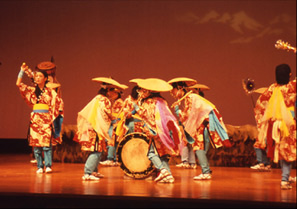
| Classification | Ken dance |
|---|---|
| name | A great-grandson Hinako Ken dance |
| alias | Great grandson in the street Hinako sword dance |
| Designated date | August 1, 1989 |
| Holding group | Great-grandson Hinako Ken dance preservation society |
| location | Wakamachi Kitakami City |
watch video
Great-grandson Hinako Ken dance
Overview
It is said that it is a representative group dance of Hinako Ken Dance that has been handed down to the Waga region along with Hinako Ken Dodoji, and that it has the tradition that it was started by a great master as well as a doji. While performing colorful dances and drumming with a focus on girls, it is a valuable performing art that has a religious aspect in which a nembutsu repercussion is performed and a virgin dance to serve God and the ancestors. The program is the 11 items from the shaven to the whistle, and the composition of the performing arts is in the order of "street", "su (redirected)", "boshan", "Iwa", "honmai" and "street". Although both the program and the composition are common to the wayside, there are programs and swings that are not communicated to the wayside, and it is thought that they are more old-fashioned. It dances as a spirit offering for the Bon Festival at Soto Seokyeongchang Temple on August 16 (referred to as the summer sword dance), and is also dedicated (called the autumn sword dance) to the annual festival of the Furudate Shinto shrine on September 9 of the lunar calendar. As a major activity of the Contracting Association, which is a mutual aid organization during the Shosei period, it can be noted as a performing arts that played a role in the creation of villages, such as performing rice transplant dance on New Year's Day and Hinako Ken Dance to the tray with the same members.
Main performance place
Gyeongchangji Temple (August), Furudate Shrine Regular Festival (October)
